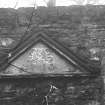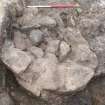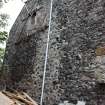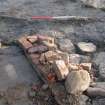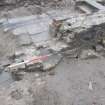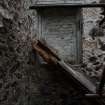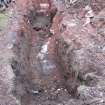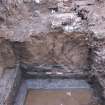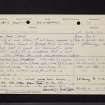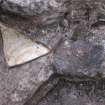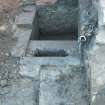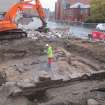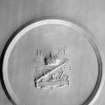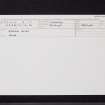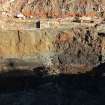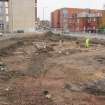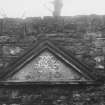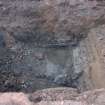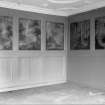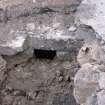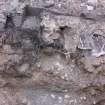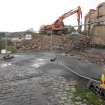Edinburgh, Gorgie Road, Gorgie House
House (Period Unassigned)
Site Name Edinburgh, Gorgie Road, Gorgie House
Classification House (Period Unassigned)
Canmore ID 52708
Site Number NT27SW 8
NGR NT 2248 7214
Datum OSGB36 - NGR
Permalink http://canmore.org.uk/site/52708
- Council Edinburgh, City Of
- Parish Edinburgh (Edinburgh, City Of)
- Former Region Lothian
- Former District City Of Edinburgh
- Former County Midlothian
NT27SW 8 2248 7214.
Gorgie House (Site of).
Site of much altered 17th century house acquired by John Brown, tenant of Gorgie Mill in 1656, so earliest part of house is presumably prior to that date. It is supposed that a mill was there between 1500 and 1600. Name Book 1855.
Gorgie Manir House: (NT 2248 7214) Earliest mention of a manor house is in 1527 when Sir James Hamilton of Finnart granted a charter of it to his cousin James Hamilton of Schawfield. The house was originally L-shaped, but was considerably added to and altered in the early 18th and 19th centuries... (Smith 1928).
A 17th century house...(RCAHMS 1929).
J Smith 1928; RCAHMS 1929.
No trace of the ancient manor house remains; the old mill stream passes adjacent to the site.
Visited by OS 23 December 1953.
The site is contained in the purlieus of a cinema.
Visited by OS 28 January 1954.
Edinburgh Public Library (Edinburgh Room).
Manuscript notes by John Smith. (1938).
Archaeological Evaluation (1 November 2011 - 4 November 2011)
NT 2248 7214 An evaluation was undertaken 1–4 November 2011 at 396–410 Gorgie Road, prior to the proposed development of student accommodation. A total of five trenches were excavated, two of which were placed on the supposed site of Gorgie House. This was dated to the 17th century by the RCAHMS during a site visit prior to its demolition in 1937. These trenches contained the remains of a square building present on the 1855 OS 1st Edition map and probably associated with the 19th-century industrial buildings to the S and W. No trace of a medieval or early post-medieval structure was located and it is possible that Gorgie House was sited to the NE, outside the development area. The remaining trenches uncovered the remains of a recently demolished early 19th-century building and an associated wooden structure.
Archive: RCAHMS (intended). Report: CECAS and RCAHMS (intended)
Funder: Chamic Developments Ltd
Ross Murray, Headland Archaeology Ltd
2012
Excavation (29 October 2014 - 13 November 2014)
Headland Archaeology (UK) Ltd undertook a programme of archaeological works on a site at 396 Gorgie Road, Edinburgh. The work was required to support a planning application (Planning Ref 11/02827/FUL) for a proposed development. The programme revealed significant archaeological remains that span a period representing the transition of Gorgie from an area of agriculture to one of Edinburgh's industrial centres.
The excavation demonstrated that there were multiple phases of activity on the site starting with small scale agricultural activity in the 17th-18th Century as well as a substantial building with an external tower staircase. A mill was constructed, possibly in the 17th but more likely, in the 18th Century. This was subsequently expanded and more widespread industrial activity took place from the late 18th Century until the 20th Century. This most likely involved the drying of grains and legumes.
Funder: 3DReid
Headland Archaeology UK Ltd
Trial Trench (21 October 2014 - 22 October 2014)
Headland Archaeology (UK) Ltd undertook a programme of archaeological works on a site at 396-410 Gorgie Road, Edinburgh, including Trial Trenching. The work was required to support a planning application (Planning Ref 11/02827/FUL) for a proposed development. The programme later revealed significant archaeological remains that span a period representing the transition of Gorgie from an area of agriculture to one of Edinburgh's industrial centres.
Excavation (10 November 2015 - 10 December 2015)
Headland Archaeology (UK) Ltd undertook a programme of archaeological works on a site at 396 Gorgie Road, Edinburgh. The work was required to support a planning application (Planning Ref 11/02827/FUL) for a proposed development. The excavation demonstrated that there were multiple phases of activity on the site starting with the construction of a mill wall, lade and operation of timber-lined tanning pits during the early 19th century. The site continued in development with the construction and operation of a set of mill buildings in the mid to late 19th century which were restructed on multiple occasions into the 20th century.
During the excavation no features relating to earlier periods were encounted and the presence of the natural geology seen directly beneath the tanning pits indicated that nothing earlier had survive the development process during the 18th and 19th centuries.
Funder: 3DReid
Information from Ross Murray (Headland Archaeology (UK) Ltd) June 2016. OASIS ID: headland1-318985
Watching Brief (12 April 2016)
The aim of this watching brief was to locate and assess the condition of the culvert running north to south alongside the western edge of the site. Three trenches were proposed in order to find the culvert, however at the current stage of development trench A, and the western halves of trenches B and C were inaccessible due to running through access to currently functioning businesses.
































